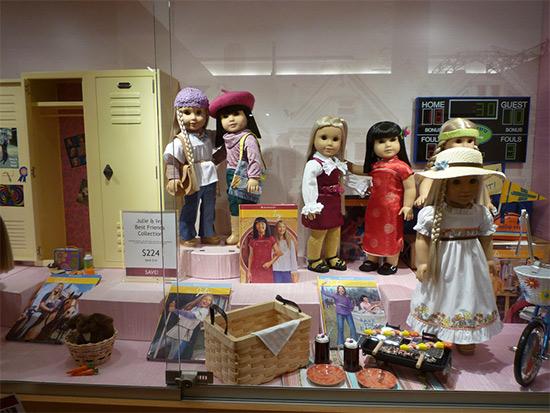Dear Ms. Spanos,
My name is Lisa Owen and I am a writer and blogger at My So Called Glamorous Life: the Adventures of a Domestic Engineer. More importantly, I am a wife and mother to two spirited and doll loving girls, ages six- and seven-years-old. We are huge fans of American Girl, with eight dolls in our collection (Bitty Babies, Bitty Twins, and My American Girl) and have attended excursions while enjoying lunch, tea, and dinner at a couple of your locations (Houston and, our favorite, Chicago). We own several of your books including The Care and Keeping of You, 1 (an excellent book!) and the accompanying journal. Your stores are magical, tending to every detail of these dolls’ storied lives, to the delight of my girls and millions of others worldwide. Therefore, it is with great disappointment that I write this letter.
Recently, you announced that you would retire four of your Historical Dolls: Marie–Grace, Cecile, Ruthie, and Ivy. I, and others, have noted that once they are retired, your historical collection will include very few dolls of color. In fact, there will be one African American doll (Addy), one Native American doll (Kaya) and one Latina doll (Josefina) out of 18 characters. You are retiring the only Asian American doll. Your announcement hinted at new dolls and/or marketing strategy (#BeForever) in the coming months, but your choice of which dolls to retire concerns me.
I’m sure that your decision has something to do with sales (although speaking personally, my six-year-old has been saving money to buy Cecile for months now), but it’s hard for me to believe that the significance of retiring these particular dolls didn’t occur to you.
The truth is, I’ve been keeping an eye on you for some time now. While I consider your brand to be overall wholesome and good for the girls, I have also noted that your offerings are not really reflective of the changing ethnic makeup of the country, particularly when it comes to the Girl of the Year. Each year, beginning around November, my girls and their friends start to get really excited with anticipation of the release of the new doll and, inevitably, that doll is white (and oddly, overwhelmingly blonde and blue eyed). Since the introduction of the first American Girl of the Year in 2001, only three have been girls of color: Knani, who is Hawaiian, Marisol, who is Latina, and Jess, who is actually mixed race (Japanese, Scottish, and Irish).
This has become increasingly frustrating and somewhat puzzling since the face of America is changing. Currently, racial and ethnic minorities make up about half of children under the age of 5-years-old. In five years they will represent more than half of the demographic of those 18-years-old and under. Yet, the American Girl brand clings very closely to one narrative of who represents an American girl.
As with any business, I am sure that your sales and marketing team determine what dolls, and their accessories, will sell best and who to target with their marketing strategies. However, consider this: More and more brown girls are being parented by white parents—parents who want to honor them and embrace their ethnicity. Additionally, all the brown girls that I know—including, but not limited to, African American, Indonesian, Sri Lankan, Korean, Vietnamese, Somalian, Ethiopian, Indian, Brazilian, Guatemalan, Mexican, Trinidadian (and the list can go on)—have American Girl dolls. Some of these girls are first generation, but they are all, each of them, American girls.
My daughters and I are African American and while we enjoy your store and appreciate the My American Girl dolls that reflect our own ethnicity, there seems to be a disconnect between your product offerings and many of the girls, and their credit card wielding mothers, who buy them. Additionally, even if the majority of your customers are Caucasian, is it not desirable that we would encourage our girls to expand their knowledge of people of different ethnicities? To embrace our differences rather than focus only on those who look just like us? My children have dolls of more than one race because it reflects their immediate social circle and the country that we live in.
If in fact the goal of American Girl is to predominantly focus on only one type of American girl, then I can accept that and I can take my business elsewhere. However, I really would be surprised if that is the case, both for social and business reasons. I need to tell you that your current offerings of Historical and Girl of the Year dolls scream of tokenism. I am aware that your company has stated that often decisions made about discontinuing certain dolls are made when there are similarities between products, but surely you can see where that can’t be quite accurate? Ivy Ling is the only Asian American Historical doll. On the other hand, you have a plethora of white dolls, some of whom look amazingly alike.
May I ask you, when it comes to product development, do you have any people of color in key decision-making positions? If the answer is no, maybe it’s time to diversify and develop a fresh perspective.
My American Girls
My American Girls.
Ms. Spanos, I really hope that this is merely a bump in the road and that my girls, and the many American girls of color who are fans of your brand, can find a way to be represented in a meaningful way going forward. I appreciate your careful consideration of my letter (which will be also be publicly posted on my website and elsewhere) and hope that this can be the beginning of open, constructive dialog as it pertains to American girls of all ethnicities.
I look forward to hearing from you.
Sincerely,
Lisa Owen
















